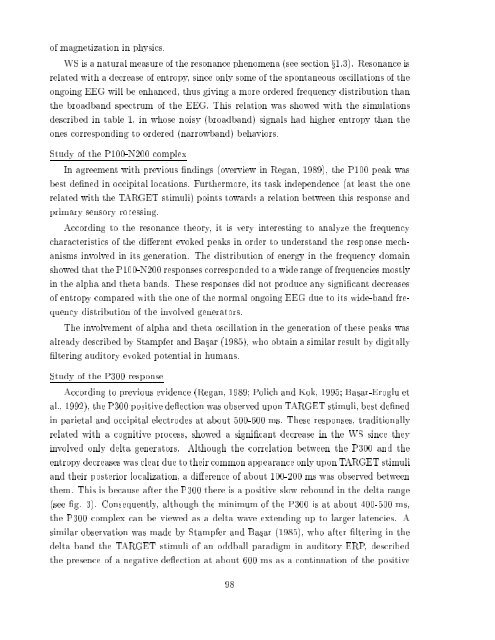Quantitative analysis of EEG signals: Time-frequency methods and ...
Quantitative analysis of EEG signals: Time-frequency methods and ...
Quantitative analysis of EEG signals: Time-frequency methods and ...
You also want an ePaper? Increase the reach of your titles
YUMPU automatically turns print PDFs into web optimized ePapers that Google loves.
<strong>of</strong> magnetization in physics.<br />
WS is a natural measure <strong>of</strong> the resonance phenomena (see section x1.3). Resonance is<br />
related with a decrease <strong>of</strong> entropy, since only some <strong>of</strong> the spontaneous oscillations <strong>of</strong> the<br />
ongoing <strong>EEG</strong> will be enhanced, thus giving a more ordered <strong>frequency</strong> distribution than<br />
the broadb<strong>and</strong> spectrum <strong>of</strong> the <strong>EEG</strong>. This relation was showed with the simulations<br />
described in table 1, in whose noisy (broadb<strong>and</strong>) <strong>signals</strong> had higher entropy than the<br />
ones corresponding to ordered (narrowb<strong>and</strong>) behaviors.<br />
Study <strong>of</strong> the P100-N200 complex<br />
In agreement with previous ndings (overview in Regan, 1989), the P100 peak was<br />
best dened in occipital locations. Furthermore, its task independence (at least the one<br />
related with the TARGET stimuli) points towards a relation between this response <strong>and</strong><br />
primary sensory rocessing.<br />
According to the resonance theory, it is very interesting to analyze the <strong>frequency</strong><br />
characteristics <strong>of</strong> the dierent evoked peaks in order to underst<strong>and</strong> the response mechanisms<br />
involved in its generation. The distribution <strong>of</strong> energy in the <strong>frequency</strong> domain<br />
showed that the P100-N200 responses corresponded to a wide range <strong>of</strong> frequencies mostly<br />
in the alpha <strong>and</strong> theta b<strong>and</strong>s. These responses did not produce any signicant decreases<br />
<strong>of</strong> entropy compared with the one <strong>of</strong> the normal ongoing <strong>EEG</strong> due to its wide-b<strong>and</strong> <strong>frequency</strong><br />
distribution <strong>of</strong> the involved generators.<br />
The involvement <strong>of</strong> alpha <strong>and</strong> theta oscillation in the generation <strong>of</strong> these peaks was<br />
already described by Stampfer <strong>and</strong> Basar (1985), who obtain a similar result by digitally<br />
ltering auditory evoked potential in humans.<br />
Study <strong>of</strong> the P300 response<br />
According to previous evidence (Regan, 1989 Polich <strong>and</strong> Kok, 1995 Basar-Eroglu et<br />
al., 1992), the P300 positive deection was observed upon TARGET stimuli, best dened<br />
in parietal <strong>and</strong> occipital electrodes at about 500-600 ms. These responses, traditionally<br />
related with a cognitive process, showed a signicant decrease in the WS since they<br />
involved only delta generators. Although the correlation between the P300 <strong>and</strong> the<br />
entropy decreases was clear due to their common appearance only upon TARGET stimuli<br />
<strong>and</strong> their posterior localization, a dierence <strong>of</strong> about 100-200 ms was observed between<br />
them. This is because after the P300 there is a positive slow rebound in the delta range<br />
(see g. 3). Consequently, although the minimum <strong>of</strong> the P300 is at about 400-500 ms,<br />
the P300 complex can be viewed as a delta wave extending up to larger latencies. A<br />
similar observation was made by Stampfer <strong>and</strong> Basar (1985), who after ltering in the<br />
delta b<strong>and</strong> the TARGET stimuli <strong>of</strong> an oddball paradigm in auditory ERP, described<br />
the presence <strong>of</strong> a negative deection at about 600 ms as a continuation <strong>of</strong> the positive<br />
98




